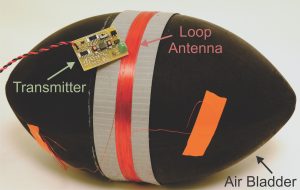Sports officials may soon have a better way of determining whether a football team has achieved a first down or scored a touchdown. Researchers from North Carolina State University, Carnegie Mellon University and Disney Research have developed a new system capable of accurately tracking a football in three-dimensional space using low-frequency magnetic fields.
The new technology is expected to be especially useful in situations where the ball is physically blocked from officials’ view, such as when ball carrier is tackled by a group of players and buried underneath them. Previous attempts to design similar ball-tracking technology have used high frequency radio waves, but these systems have proved ineffective in such pile-ups because HF waves are absorbed by the players’ bodies. Spectators could also better enjoy games in low-visibility conditions, such as in heavy rain or snow, because the technology could help them more easily follow the ball.
“Low frequency magnetic fields don’t interact very strongly with the human body, so they are not affected by the players on the field or the stadium environment,” David Ricketts, Ph.D., an associate professor of electrical and computer engineering at NC State and senior author of a paper describing the research, said. “This is part of what makes our new approach effective.”

The ball-tracking system is comprised of a low frequency transmitter integrated into a football and antennas placed around the football field, which use signals received from the transmitter to track the location of the ball. A video demonstration of the technology posted on the Disney Research website can be viewed here.
To get the system to function properly, however, researchers needed to overcome a complicating factor. When low frequency magnetic fields come into contact with the ground, they are essentially absorbed by the earth and re-emitted, creating a secondary field that interacts with the original field and confuses the antennas, affecting the technology’s accuracy.
“We realized that we could use a technique developed in the 1960s called complex image theory [to fix this issue], Darmindra Arumugam, Ph.D., lead author of the paper and a former Ph.D. student at Carnegie Mellon now at NASA’s Jet Propulsion Laboratory, said. “Complex image theory allows us to account for the secondary fields generated by the earth and compensate for them in our model.”
The system is still being fine-tuned, but ultimately the researchers hope to get its accuracy down to half the length of a football, which is “the estimated margin of error for establishing the placement of the football using eyesight alone,” Ricketts said.
The paper, “Three-Dimensional Position and Orientation Measurements Using Magnetoquasistatic Fields and Complex Image Theory,” was published online this month in IEEE Antennas and Propagation Magazine.





